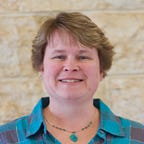Universal Design and the Path to a Doctoral Degree
Sandy Welfare, OT Student at The Universal Design Project, discusses how life influenced her desire to help change the built environment.
April was “Occupational Therapy Month.” This year during April I completed my last Level 2 Fieldwork placement (a 3-month unpaid internship, during which a student gradually takes over the job of their supervisor to learn the job under supervision), passed a competency exam, and began my doctoral project, known in our program as the “Doctoral Experiential Component” or DEC. Occupational therapy (OT) helps people become more independent, focusing on tasks (occupations) such as bathing, grooming, taking care of pets, paying bills, performing in leisure activities, and many other things we tend to take for granted until we need help doing them.
I was matched with The Universal Design Project for my DEC nearly two full years ago, prior to knowing specifically what path I would choose to take for my OT career. As it turns out, I have chosen hand therapy thanks to that wonderful fieldwork experience that ended in April. The nice thing about OT is that no matter what specialty you choose— acute care, outpatient, inpatient, hand therapy, school system, pediatrics, mental health — universal design can be an integral part and can be incorporated for the benefit of all.
Meet my daughter Julia, who was born in 1997 with a condition called Lissencephaly, which is a deformation of the brain causing profound developmental delay. It is through Julia that I first realized how unfriendly our built environment is for people with disabilities. Julia was never able to walk or talk even hold her head up on her own. She required round-the-clock care and needed a lot of equipment in order to go out and about to explore the world.
Would you want to lay your child down on the floor in a public restroom to change their diaper?
It surprised me how often even “accessible” places such as a mall or grocery store had a half-inch rise at the threshold, which would jar Julia enough to make her cry out when rolling over it in a wheelchair. Sometimes thresholds caused a dead stop. If she had not been strapped in, she could have flown out! Changing rooms and restrooms at public facilities might have a changing table suitable for a newborn, but have you ever seen one that could accommodate a 13-year-old or an adult? Would you want to lay your child down on the floor in a public restroom to change their diaper?
I have to admit, these considerations never occurred to me until they became part of my daily life. We had to leave a church I loved because Julia could not get up the steps. My parents went to great expense to build an accessible patio with a ramped entrance so their granddaughter could visit, but we could not visit most of our friends’ homes or go to their parties. Julia, in her special wheelchair, carrying all of her equipment (oxygen tank, pulse oximeter, feeding pump, suction machine, and other supplies) made quite an entrance wherever she went.
When I first matched with The Universal Design Project, like most people my impression of universal design (UD) was purely about physical accessibility. Certainly, that is a part of the concept. But UD, as defined by innovator Ronald Mace, is the idea that an environment or a product could be designed to be “usable by all people, to the greatest extent possible, without the need for adaptation or specialized design.” Think of something like a keyless entry to a car which opens the door automatically. This is usable by a large number of people. Certainly, it is beneficial for a person with a disability, but it is also helpful to a parent with young children, or a person carrying groceries. Think about our new favorite gadgets such as “Alexa” and “Siri” — voice-activated devices which can turn on our lights, play a particular song, or change the temperature of our bedroom without us having to get out from under the warm blanket. These gizmos can be used by anyone, but can be life-changing for a person with disabilities to take care of everyday household tasks independently.
Julia passed away in 2011 at the age of 13. For thirteen years my goals had been keeping her alive and helping her experience the world. When she passed away I was 41 years old and had to figure out what I wanted to be when I grew up. I chose to become an occupational therapist because — of all the medical personnel we encountered in Julia’s life — it was occupational therapists who did the most to improve her quality of life: her ability to participate in school and church, her comfort, her joy in the discovery of animals and music and colors.
The OTs at school introduced me to gadgets and devices I had no idea existed. They helped me interact with Julia in ways I had not imagined. They opened up a world for us to explore and experience together.
With The Universal Design Project, I hope to help open that world for other people to experience— the most people possible with the least amount of adaptation and specialization necessary. Over the next few months you will hear more about my project, and I hope you will be as excited about it as I am. Watch this publication for more updates on what The Universal Design Project is up to!
